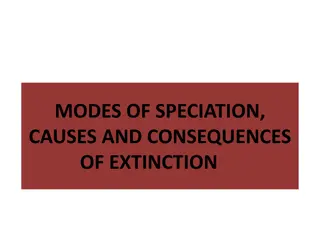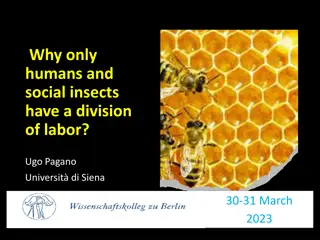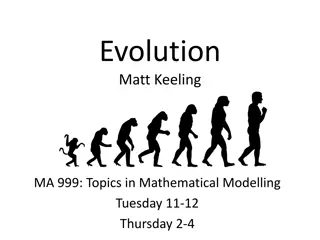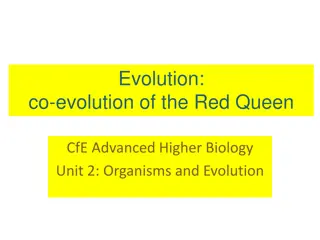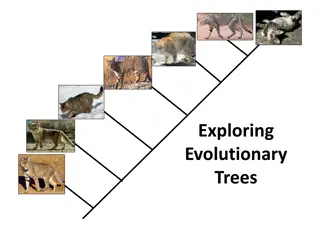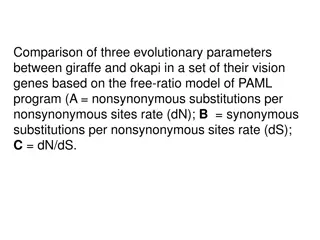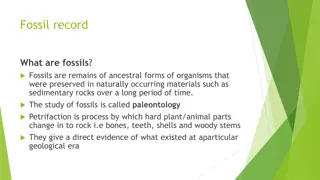Understanding Species Concepts in Evolutionary Biology
Explore the various species concepts in evolutionary biology, including biological and morphological definitions, critical thinking on species boundaries, and the challenges of defining species based on reproductive isolation and morphological differences. Dive into key concepts like speciation, human evolution, and the patterns of macroevolution.
Download Presentation

Please find below an Image/Link to download the presentation.
The content on the website is provided AS IS for your information and personal use only. It may not be sold, licensed, or shared on other websites without obtaining consent from the author. Download presentation by click this link. If you encounter any issues during the download, it is possible that the publisher has removed the file from their server.
E N D
Presentation Transcript
Lecture #3 Origin of Species Cartoon gentleman and ape 1
Key Concepts: Species concepts Development of reproductive isolation Patterns of speciation Macroevolution Human evolution Evolution continues .. 2
My pet peeve is . specie Species is both singular and plural 3
Major Species Concepts Biological Morphological Phylogenetic Diagram variation in beaks between species 4
Biological species the basic standard for separating species(Ernst Mayr, 1942) Species are defined by natural reproductive isolation Individuals that can produce successful offspring are considered the same species Image Sarracenia rubra Image Sarracenia flava 5
Critical Thinking Biological species are defined by natural reproductive isolation Individuals that can produce successful offspring are considered the same species Definition doesn't always work why not??? 6
Critical Thinking Biological species are defined by natural reproductive isolation Individuals that can produce successful offspring are considered the same species Definition doesn't always work Speciation often occurs as the gradual divergence of multiple populations Fuzzy boundaries during divergence Also, can t be used to classify extinct species 7
Morphological species the first way to separate species(Linnaeus, ~1750 & others) Species are defined by differences in form Individuals with the same morphology and/or anatomy are considered the same species Image Hymenocallis coronaria Image Hymenocallis floridana 8
Critical Thinking Morphological species are defined by differences in form Individuals with the same morphology and/or anatomy are considered the same species Definition doesn't always work why not??? 9
Critical Thinking Morphological species are defined by differences in form Individuals with the same morphology and/or anatomy are considered the same species Definition doesn't always work Some species have a lot of natural phenotypic variation But, the only way to classify extinct species and species that lack sexual reproduction Also important in describing new species 10
Phylogenetic species the new standard for separating species??? Species are defined based on evolutionary history Species defined by the smallest monophyletic group in an evolutionary tree Monophyletic = lineage is derived from a common ancestor Definition doesn't always work Don t have good phylogenies for all species or groups Also, imperfect agreement on interpretations 11
Development And Maintenance Of Reproductive Isolation: the essence of speciation It is generally accepted that natural reproductive isolation defines and preserves separate species in sexually reproducing organisms What constitutes a barrier to reproduction? How do reproductive barriers develop? 12
Pre-zygotic Barriers Remember, the zygote is the fertilized egg cell The first cell of the new offspring Pre-zygotic barriers prevent the formation of the zygote Natural, evolved incompatibilities prevent successful fertilization Habitat isolation Behavioral isolation Temporal isolation Structural isolation Chemical isolation Image blue-footed boobies mating behavior 13
Critical Thinking Natural, evolved incompatibilities prevent successful fertilization Think of some examples of: Habitat isolation Behavioral isolation Temporal isolation Structural isolation Chemical isolation Euphorbia in very xeric habitat 14
Critical Thinking Habitat isolation different ecological niches Behavioral isolation changes in mating behaviors . Temporal isolation the timing of reproductive events Structural isolation mutations that change morphology of reproductive structures Chemical isolation gametes must be compatible, pollen must match 15
Post-zygotic Barriers Post-zygotic barriers prevent successful development of offspring Hybrids don t develop properly Hybrids don t reach sexual maturity Hybrids don t produce viable gametes Hybrid lineages fail over time Natural genetic incompatibilities prevent successful long-term reproduction Horse x Donkey = robust but sterile Mule 16
Critical Thinking The Darwinian fitness of an individual is measured by a.its ability to reproduce. b.how long it lives. c.the number of mates it attracts. d.the number of its offspring that survive to reproduce. e.its physical strength. 17
Critical Thinking The Darwinian fitness of an individual is measured by a.its ability to reproduce. b.how long it lives. c.the number of mates it attracts. d.the number of its offspring that survive to reproduce. e.its physical strength. 18
Patterns of Speciation Barriers result from separations that persist long enough that eventually new species have developed Diagram different species of fish in separated ponds 19
Patterns of Speciation Pattern depends on the mechanism of gene flow interruption Allopatric speciation occurs when populations are separated by a geographical barrier Sympatric speciation occurs in the absence of a geographic barrier 20
Critical Thinking Allopatric speciation occurs when populations are separated by a geographical barrier Such as???? How could such barriers form??? 21
Critical Thinking Allopatric speciation occurs when populations are separated by a geographical barrier Such as rivers, canyons, mountains, oceans, glaciers .. How could such barriers form??? Diagram showing development of a canyon 22
Critical Thinking Allopatric speciation occurs when populations are separated by a geographical barrier Such as rivers, canyons, mountains, oceans, glaciers .. How could such barriers form??? Geological processes Mountain building River erosion Glaciation Tectonic events Cave formation 23
Critical Thinking Also . Climate changes that cause large lakes to dry up or form smaller, isolated lakes Colonization events that separate a group from the rest of the population (founder effect) 24
Allopatric Speciation Once populations are physically isolated, speciation may occur due to all the evolutionary processes we talked about earlier Selection Drift Selective mating Mutation 25
Critical Thinking What if the isolated population is small??? What if the isolated population is from edge of the range of the original population??? 26
Critical Thinking What if the isolated population is small??? Speciation is likely to occur more rapidly More genetic drift, less gene flow What if the isolated population is from edge of the range of the original population??? 27
Critical Thinking What if the isolated population is small??? Speciation is likely to occur more rapidly More genetic drift, less gene flow What if the isolated population is from edge of the range of the original population??? It may be even more likely to diverge Probably already adapting to frontier or edge conditions Also, probably more likely to migrate 28
Allopatric Speciation due to geographic separation Plants???? Birds???? Images different species of chipmunk on either side of the Grand Canyon 29
Speciation may, or may not, occur Diagram sympatric allopatric either sympatric again or not, as a population separates around a mountain range and then re-unites 30
Sympatric Speciation Occurs when a population becomes reproductively isolated without geographic barriers Mutations or selection pressures that lead to changes in behavior, habitat, food source, phenology . Errors in meiosis that lead to polyploidy (some plants can be self- fertile, vegetative reproduction) Hybrids that develop into fertile populations through vegetative reproduction or multiple events (mostly plants) Diagram sympatric speciation in a forest environment 31
Sympatric Speciation Occurs when a population becomes reproductively isolated without geographic barriers Mutations or selection pressures that lead to changes in behavior, habitat, food source, phenology . Errors in meiosis that lead to polyploidy (some plants can be self- fertile, vegetative reproduction) Hybrids that develop into fertile populations through vegetative reproduction or multiple events (mostly plants) Diagram meiosis errors 32
Polyploidy one mechanism for sympatric speciation Diagram errors in meiosis can lead to polyploids Some plants can self-pollinate, or vegetative reproduction can produce multiple fertile individuals 33
Sympatric Speciation Occurs when a population becomes reproductively isolated without geographic barriers Mutations or selection pressures that lead to changes in behavior, habitat, food source, phenology . Errors in meiosis that lead to polyploidy (some plants can be self-fertile, vegetative reproduction) Hybrids that develop into fertile populations through vegetative reproduction or multiple events (mostly plants) Image showing hybrid asters 34
Speciation is NOT a Given Must have an interruption to gene flow PLUS Must have enough change in the separated populations to produce a barrier to reproduction 35
Endemic Species and Adaptive Radiation Endemic species = restricted in distribution to a particular place, generally because they evolved in place Volcanic island chains often contain many endemic species No biota until they were colonized by a few individuals (founder effect) These small populations then evolved into new species Allopatric speciation due to the geographic barrier from the founder effect But also 36
Endemic Species and Adaptive Radiation Many new species develop that are adapted to the diverse new habitats found in such islands Sympatric speciation No geographic barriers Adaptive radiation into new habitats Diagram showing adaptive radiation 37
Adaptive Radiation Galapagos finches and Hawaiian honeycreepers Diagrams adaptive radiation in birds 38
Adaptive Radiation is a common theme both between and within lineages Diagram mass extinctions over the past 2.5 billion years Diagram diversification of mammals after extinction of the dinosaurs 39 Mass Extinction Events Mammals
Critical Thinking Humans have initiated a mass extinction event Will life cease to exist on the planet??? Can we destroy the planet??? 40
Critical Thinking Humans have initiated a mass extinction event Will life cease to exist on the planet??? Highly unlikely There will just be a new set of species Can we destroy the planet??? 41
Critical Thinking Humans have initiated a mass extinction event Will life cease to exist on the planet??? Highly unlikely There will just be a new set of species Can we destroy the planet??? Highly unlikely The earth has survived for at least 4 billion years! Species come and go . 42
Speciation is a Constant When migration, isolation or other selection pressures force divergence, reproductive isolation can eventually lead to speciation Speciation might be gradual or abrupt (punctuated equilibrium) Transitions (either gradual or abrupt) may or may not be captured in the fossil record 43
Macroevolution: larger-scale changes in organisms Also contributes to speciation Small, population-scale changes can accumulate Exaptations traits can be co-opted Feathers for thermoregulation feathers for flight Large phenotypic changes can result from small changes in regulatory genes Control over the timing and length of developmental events, or the spatial organization of body parts 44
Critical Thinking Was the evolution of the modern horse a series of directed events ???? Diagram phylogeny of the modern horse 45
Critical Thinking Was the evolution of the modern horse a series of directed events??? No, there are lots of lineages that are now extinct Evolution may look directed, but it s not.... 46
A Preview of the Taxonomic Hierarchy: this is how we classify diversity Taxonomic Category Example (taxon) Domain Eukarya = all eukaryotic organisms Kingdom Plantae, also Metaphyta = all plants Division (phylum) Magnoliophyta = all angiosperms Class Liliopsida = all monocots Order Asparagales = related families (Orchidaceae, Iridaceae, etc) Orchidaceae = related genera (Platanthera, Spiranthes, etc) Platanthera = related species (P. ciliaris, P. integra, etc) ciliaris = one species Family Genus Specific name/epithet 48
Images the yellow fringed orchid 49 Platanthera ciliaris
Humans can also be classified! Domain eukarya Kingdom animal Phylum chordates Sub-phylum vertebrates Class mammals Order primates Family hominoids Genus Homo Specific epithet sapiens Image of human fossil 50






